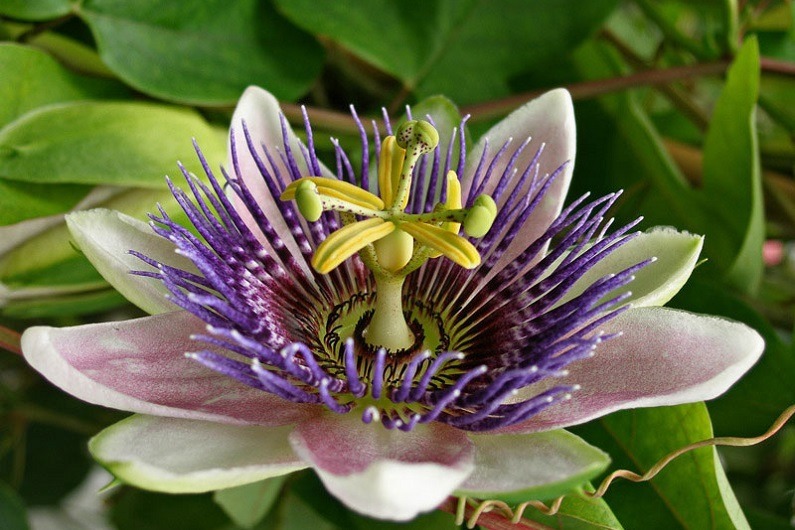Passiflora, commonly known as Passionflower, is a captivating plant that belongs to the Passifloraceae family. Originating from diverse regions such as Australia, Asia, America, and Madagascar, this herbaceous vine is celebrated not only for its strikingly beautiful blooms but also for its vigorous growth and ease of cultivation. Its exotic allure makes it a popular choice for garden enthusiasts and beginners alike, who are eager to add a touch of tropical elegance to their indoor or outdoor spaces.
Understanding the Characteristics of Passiflora
One of the most appealing aspects of Passiflora is its robust growth habit. This perennial climber can reach an impressive length of up to 3 meters, with annual shoots extending approximately 2.5 meters. As a liana, it demonstrates a climbing nature, making it ideal for training along supports such as trellises, arches, or even hanging baskets, where it can showcase its natural elegance.
In terms of lifespan, Passiflora is a durable perennial. Its perennial nature means that it can bring joy and beauty year after year, provided it receives the appropriate care. Despite its propensity to flourish, attention to specific cultural requirements is essential to ensure longevity and exuberant performance.
Optimal Conditions for Thriving Growth
To cultivate Passiflora successfully, understanding its ideal environmental conditions is crucial. During the summer months, it is preferable to keep temperatures from rising above 75.2°F. Conversely, in winter, the plant benefits from a resting period, thriving in cooler conditions of around 53.6-64.4°F. Regularly misting the foliage with soft water (2-3 times per week)—taking care to avoid the flowers—helps maintain the high humidity levels this tropical plant loves. For added moisture, placing the pot on a tray filled with wet expanded clay is recommended.
Lighting is another critical factor for optimal growth and vibrant blooms. Passiflora thrives in bright light and benefits from a certain amount of direct sunlight. Insufficient lighting can result in weak blooming or no flowering at all, highlighting the importance of correct positioning.
Soil, Watering, and Fertilization
The soil for Passiflora should be well-draining and breathable. To improve soil structure, incorporations of sand or perlite with peat are often recommended if standard soils are too dense. For those who enjoy creating their own soil mixes, combining three parts leafy soil, two parts turfy ground, two parts humus, and one part sand yields excellent results. A pot with drainage holes is essential to prevent excess moisture, which can lead to root rot.
Throughout the growing season, maintaining consistent soil moisture is key. Watering every other day during the summer is advisable, while in winter, this should be scaled back to once every 7-10 days. It’s vital to ensure that any excess water is drained from the pan to root health. During active growth stages, applying a diluted liquid fertilizer for flowering plants twice a month can promote vigorous development and abundant blooms.
Propagation Techniques and Pruning
Propagation of Passiflora can be achieved through several methods. Apical cuttings measuring 8-10 cm long—complete with multiple buds—can be rooted in a moist mixture of peat and sand at a temperature range of 68-77°F. For successful rooting, it’s beneficial to cover the container with polyethylene, with the process typically taking about a month. Alternatively, cuttings can also root in water or propagate with seed sowing in February, utilizing a substrate comprising leaf mold, humus, peat, and sand.
Pruning is an integral part of Passiflora care. After flowering, each shoot should be pruned back to the ground. In spring, thinning of the shoots is beneficial for better blooming potential, with new growth trimmed back by a third of their length. Since flowers only appear on current-year growth, this approach fosters a prolific display of blooms the following growing season.
Addressing Common Challenges
Like many plants, Passiflora may face challenges from pests such as mealybugs, spider mites, shield insects, and aphids. Early detection and action are crucial for effective management. Environmental stressors, such as low temperatures or lack of moisture, can cause issues like leaf twisting, yellowing, and premature leaf drop. Maintaining the appropriate temperature, humidity, and watering routine is essential to the plant’s health.
Additionally, insufficient light levels lead to chlorosis or slow growth, while excess fertilization can inhibit flowering, contrary to popular belief. As with any climber, supporting structures are vital for directing growth, giving Passiflora the ability to show its full potential.
In conclusion, Passiflora stands as a symbol of exotic allure and botanical resilience. Its enchanting blooms and lush growth captivate those who choose to grow it, whether indoors or out. By paying attention to its environmental preferences—such as temperature, lighting, and humidity—enthusiasts can ensure that their Passiflora thrives. Proper soil composition, regular watering, and mindful fertilization further contribute to this plant’s success. By understanding and addressing its unique needs, growers can enjoy the beauty of Passiflora’s vibrant blooms and luxurious foliage for years to come. Experience the tropical elegance of Passiflora, and let its vibrant presence transform your garden into a serene retreat.






